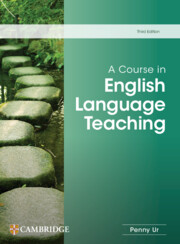Book contents
- Frontmatter
- Contents
- Acknowledgements
- Introduction
- 1 Teaching English today
- 2 The lesson
- 3 Classroom interaction
- 4 Tasks
- 5 Texts
- 6 Teaching vocabulary
- 7 Teaching grammar
- 8 Teaching listening
- 9 Teaching speaking
- 10 Teaching reading
- 11 Teaching writing
- 12 Feedback and error correction
- 13 Assessment and testing
- 14 The syllabus
- 15 Teaching/learning materials
- 16 Teaching content
- 17 Classroom discipline
- 18 Digital technology and online teaching
- 19 Learner differences 1: age
- 20 Learner differences 2: diversity and inclusion
- 21 Teacher development
- Glossary
- References
- Index
- Frontmatter
- Contents
- Acknowledgements
- Introduction
- 1 Teaching English today
- 2 The lesson
- 3 Classroom interaction
- 4 Tasks
- 5 Texts
- 6 Teaching vocabulary
- 7 Teaching grammar
- 8 Teaching listening
- 9 Teaching speaking
- 10 Teaching reading
- 11 Teaching writing
- 12 Feedback and error correction
- 13 Assessment and testing
- 14 The syllabus
- 15 Teaching/learning materials
- 16 Teaching content
- 17 Classroom discipline
- 18 Digital technology and online teaching
- 19 Learner differences 1: age
- 20 Learner differences 2: diversity and inclusion
- 21 Teacher development
- Glossary
- References
- Index
Summary
The first year of teaching
For many teachers, the first year is hard (but it gets better later!). If your first year is smooth and easy, you are one of the lucky ones. However, the need to overcome a variety of professional problems as you begin to teach results in a great deal of learning, perhaps the most effective learning there is. What you can learn from courses or books like this one is limited; there are some competencies and aspects of professional knowledge that you learn only from experience.
Pause for thought 21.1
Either a) think about your own first year teaching: how was it, and what did you learn? or b) if you haven't yet started teaching, ask an experienced teacher what their first year was like and what they learnt from it.
Comment
My first year of teaching English in a (non-English-speaking) country to which I had recently moved was in a primary school. I had two classes of 10- and 12-yearolds. I had a fairly hard time. Lessons rarely went smoothly, I had trouble getting the students to do what I wanted, and they were often cheeky. There were, it is true, some positive aspects: an end-of-year play that children and parents enjoyed; the awareness that the students were progressing; the occasional sparkle in the eyes of a child who had succeeded in a task or suddenly become aware how much they knew. However, I also remember investing an enormous amount of time and effort in preparing lessons and materials, much of which was, I felt, wasted; feelings of disappointment and sometimes humiliation. The turning point was an event at the end of that first year. I went to the class teacher of one of the classes I had been teaching and told him I thought I was unsuited to be a teacher and wished to leave. He told me to think less about my own feelings and to look at the students. ‘Ask yourself,’ he advised me, ‘what they have got out of your teaching.
- Type
- Chapter
- Information
- A Course in English Language Teaching , pp. 290 - 304Publisher: Cambridge University PressPrint publication year: 2024

